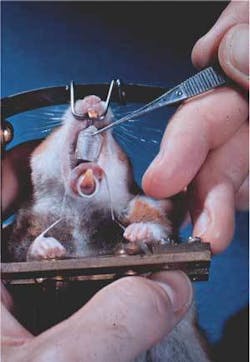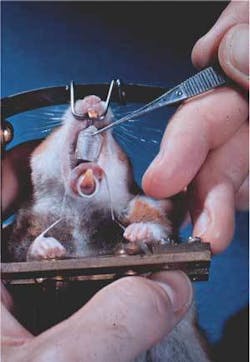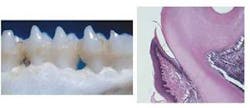Baltimore and Syrian hamsters
May was awash with professional activities and learning opportunities, but a trip to Baltimore, Md., for a continuing-education course at Mercy Hospital was the high point of my season. Let me elaborate. Dr. Paul Keyes, 89, invited me to a one-day course in which he, Dr. Tom Rams, a well-known periodontal researcher from Temple University School of Dentistry, Dr. Walter Loesche, another prominent periodontal researcher, and Dr. Larry Page, clinical professor of periodontology at Temple, were presenting lectures to dentists and hygienists from the Baltimore area.
Also attending were Sandy Sheffler, RDH, a passionate phase contrast microscope advocate, Sheila Wolf, RDH, affectionately known as “Mama Gums,” Bill Landers from Oratec, and Dr. Larry Burnett, an original “Gum Buster” who designed the Parkell ultrasonic “Burnett Power-Tip.”
What does this unique group have in common, and why was I so excited about spending a day with them? The answer is simple, and I want everyone who reads this column to get excited too. These people are non-surgical periodontal mavericks who believe passionately in enhancing non-surgical, anti-infective therapy with antimicrobial agents and microbiological testing, when appropriate, to treat chronic, anaerobic periodontal infections.
Each of these people, though a bit unorthodox, is caring, compassionate, and dedicated to his or her cause, and each has made a significant contribution. Unlike the “plastics” in the movie “Mean Girls” (a comedy about passive aggressive females), these folks are very real, unconventional, and serious. They believe in treating chronic periodontal infections with local and systemic antimicrobials, and they teach others to do the same.
Dr. Paul Keyes is probably best known for his research in dental caries, and he was the first person to discover the etiologic role of Streptococcus mutans in the pathogenesis of dental caries in 1960. Also, he invented customized vinyl trays for daily topical fluoride applications in 1964. Most dental professionals don’t know that Dr. Keyes was the first to associate Actinomyces viscosus with root caries. Before his research, caries was thought to be genetic and to occur in family units.
Dr. Keyes treated caries-susceptible Syrian hamsters with antibiotics. The offspring of these animals were caries-free, and their progeny were also caries-free. Then, when these caries-free animals were caged with caries-active animals, S. mutans was transmitted to the caries-free hamsters through infected feces. It was deduced and later confirmed that the antibiotic had eliminated the cariogenic organisms identified as S. mutans.
Dr. Tom Rams, chairman of the Department of Periodontology at Temple University School of Dentistry, stated, “Dr. Keyes pioneered many periodontal research studies, including the first one that demonstrated microbial specificity in the etiology of periodontitis in 1964.1 He conducted various other research studies on anti-infective approaches to non-surgical treatment of human periodontitis, including the use of baking soda in home oral hygiene regimens, while he was employed at the National Institute of Dental Research (NIDR-NIH).”
Meeting Dr. Keyes and hearing him lecture was like a coming home party for me. The title of his presentation was “A 30-year Perspective on Non-Surgical Periodontal Therapy,” and it was a historical journey. Dr. Keyes is a giant of a man who is short in physical stature, and I could barely see him as he stood behind the podium. He insisted that this particular lecture would be his last, and he became very emotional when he showed us a photo of one of his Syrian hamsters, which was very dear to his heart. Dr. Keyes showed the audience numerous slides of heavy plaque growth in periodontally healthy hamsters, which led to destruction of the periodontium. He also showed us periodontal health in the absence of heavy dental plaque on the tiny teeth of these little critters. He showed us a photo of experimentally induced periodontitis, and one of root caries in hamsters. (I wondered how he concocted a vinyl fluoride tray for a tiny Syrian hamster.)
Dr. Tom Rams met Dr. Paul Keyes when he began working at the NIDR-NIH in 1980. Drs. Keyes, Rams, and Loesche were aware of the periodontal research in the 1970s by Dr. Sigmund Ramfjord, which showed little difference between the clinical outcomes of non-surgical versus surgical treatment.1 When Dr. Rams met Dr. Keyes, Dr. Keyes was involved in efforts to augment non-surgical periodontal therapy with local and systemic antimicrobials, and was experimenting with microbiological testing as a basis for modulating therapy. These periodontal researchers and many others such as Jørgen Slots, Max Listgarten, Sigmund Socransky, Jan Lindhe, D. Walter Cohen, Harold Löe, Robert Genco, and Paul Cummings were all very interested in periodontal microbiology.
In addition to his work at Temple University, Dr. Rams still practices clinical periodontics using microbiological testing, augmentation of non-surgical periodontal therapy with antimicrobial chemotherapy, and the provision of extensive care and attention to each patient’s needs.1 Like Dr. Jørgen Slots at USC School of Dentistry, Dr. Rams is a proponent of inexpensive professionally delivered povidine-iodine pocket irrigation, patient home irrigation with diluted sodium hypochlorite, and systemic antibiotic therapy for refractory and aggressive forms of periodontitis and microbial laboratory testing, to determine the most appropriate systemic antibiotic and identify antibiotic resistance.2
Traditional periodontal treatment has always required professional intervention. For decades, periodontal surgery, or “pocket elimination” surgery, was performed to reduce probing depths so that the patient would have a shallow sulcus to reduce the subgingival bacterial load. Bacterial growth was suppressed by patient adherence to three-to-four-month recalls with good plaque control. This surgical approach to bacterial suppression has been successful but cost prohibitive for many patients experiencing painful wound healing and exposed roots that resulted in chronic dentinal hypersensitivity.
Like Dr. Keyes, Dr. Loesche believes that most forms of periodontal disease are associated with an overgrowth of certain anaerobic bacterial species. In contrast to those who believe that the nonspecific overgrowth of bacteria causes disease by triggering an inflammatory response, Dr. Loesche believes that it is the overgrowth of a limited number of bacterial species that can produce inflammatory changes in the periodontium.3 He has spent much of his professional career conducting research to test his “specific plaque hypothesis.”
Reducing surgical needs is a wonderful goal. We know that many forms of periodontal disease can be treated with antimicrobial agents, both local and systemic, and that these agents are directed against the responsible anaerobes. A cleaning and disinfecting approach works well for a majority of periodontal patients.
For the 15 to 20 percent who remain refractory, Dr. Loesche believes that inadequate debridement with burnished calculus, especially around molar furcations or dentinal tubules in roots, could allow certain anaerobic organisms like spirochetes to overgrow. Even when debridement is successful, the reduction in plaque flora is temporary, and recolonization of the subgingival area by motile rods and spirochetes may occur within two to eight weeks.4,5
Let’s remember our pioneering predecessors whose tenacity and dedication to the scientific method inspired us to become therapists who make a difference. Stay tuned to next month’s column. I’ll be talking to Natalie Grossman, RDH, who worked alongside Dr. Walter Loesche for almost 30 years. RDH
A videotape of the Baltimore Mercy Hospital seminar will be available for purchase in September. Please contact OraTec Co. for details.
Lynne H. Slim, RDH, BSDH, MSDH, is a practicing hygienist/periodontal therapist who has more than 20 years experience in both clinical and educational settings. She is also President of Perio C Dent Inc. (Perio-Centered Dentistry), a practice management consulting firm that specializes in creating outstanding dental hygiene teams. Lynne is a member of the Speaking and Consulting Network (SCN) that was founded by Linda Miles, and has won two first place journalism awards from ADHA. Lynne is also owner/moderator of a periodontal therapist yahoo group: http://yahoogroups.com/group/periotherapist. She can be contacted at [email protected].
References
1 Wolf S. Ed. Dr. Paul Keyes: Tributes. Radcliffe Publishing 2004.
2 Rams TE. Power Point presentation, handout. Mercy Hospital. Baltimore, Md. 2006.
3 Loeshe WJ, Grossman NS. Periodontal disease as a specific, albeit chronic infection: diagnosis and treatment. Clinical Microbiology Reviews 2001; 727-752.
4 Loesche WJ, et al. The non-surgical treatment of patients with periodontal disease: results after 6.4 years. General Dentistry 2005; 298-304.
5 Rhemrev GE, et al. Immediate effect of instrumentation on the microflora in deep inflamed pockets under strict plaque control. J Clin Periodontol 2006; 33:42-48.



